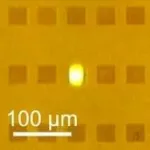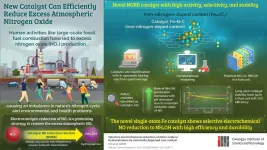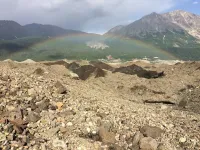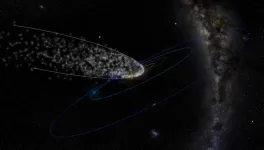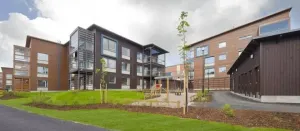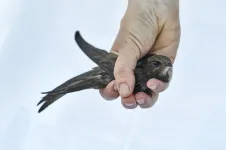(Press-News.org) A team of researchers at the University of Ottawa has found a way to use visible light to transform carbon dioxide gas, or CO2, into solid carbon forms that emit light. This development creates a new, low-energy CO2 reduction pathway to solid carbon that will have implications across many fields.
We talked to lead author Dr. Jaspreet Walia, Post-Doctoral Fellow in the School of Electrical Engineering and Computer Science at the University of Ottawa, and research lead Dr. Pierre Berini, uOttawa Distinguished Professor and University Research Chair in Surface Plasmon Photonics, to learn more.
Please tell us about your team's discovery.
Pierre Berini: "We have reduced carbon dioxide, a greenhouse gas, to solid carbon on a nanostructured silver surface illuminated with green light, without the need for any other reagents. Energetic electrons excited on the silver surface by green light transfer to carbon dioxide molecules, initiating dissociation. The carbon deposits were also found to emit intense yellow light in a process known as photoluminescence."
How did you come to these conclusions?
Jaspreet Walia: "We used a technique known as Raman Scattering to probe the reaction in real time to determine which products, if any, were forming. To our surprise, we consistently observed signatures of carbon forming on the surface, as well as bright and visible yellow light emanating from the sample."
Why is it important?
Pierre Berini: "Recently, there has been considerable global research effort devoted to developing technologies that can transform CO2 using visible light. Our work not only demonstrates that this is possible, but also that light emitting solid carbon can be formed."
What are the applications of this discovery in our lives?
Jaspreet Walia: "This fixed pathway for reagent-less CO2 reduction to light emitting solid carbon, driven by visible light, will be of interest to researchers involved in the development of solar driven chemical transformations, industrial scale catalytic processes, and light-emitting metasurfaces."
"More specifically, with respect to the creation of carbon directly from CO2 gas, our findings will have an impact on research involving plasmon assisted reactions and I would expect the emergence of applications in the oil and gas industries, where catalytic transformations involving carbon-based compounds is a key focus area."
"Next-generation reactions involving CO2 and light could also lead to other useful outcomes, such as the potential for artificial photosynthesis. Our findings could be used for light control and manipulation at the nanoscale, or to possibility realize flat light sources due to the light-emitting aspect of our discovery. The nanostructured carbon itself could also be used in catalysis."
"Finally, the wavelength (color) of the light emitted from carbon dots on a silver surface could be very sensitive to the local environment, making it an attractive sensing platform for pollutants, for example."
Is there anything you would like to add?
Pierre Berini: "We have learned how to form solid carbon deposits that emit light "out of thick air", in a breakthrough enabled by light-assisted transformation of CO2 gas driven by energetic electrons. The project was entirely driven by curiosity, with no set expectations on outcomes, and benefitted from close collaboration with graduate students Sabaa Rashid and Graham Killaire, as well as Professors Fabio Variola and Arnaud Weck."
INFORMATION:
The research took place at the uOttawa Centre for Research in Photonics, from January 2020 to present. The paper "Reconfigurable carbon quantum emitters from CO2 gas reduced via surface plasmons" is published in the journal Optica as a memorandum.
Authors:
* Jaspreet Walia (Post-Doctoral Fellow, Department of Electrical and Computer Engineering, University of Ottawa)
* Sabaa Rashid (Master's Student, Faculty of Engineering, University of Ottawa)
* Graham Killaire (Ph.D. Candidate, Department of Physics, University of Ottawa)
* Fabio Variola (Associate Professor, Department of Mechanical Engineering, University of Ottawa)
* Arnaud Weck (Full Professor, Department of Mechanical Engineering, University of Ottawa)
* Pierre Berini (Distinguished Professor and University Research Chair in Surface Plasmon Photonics. Director of the Centre for Research in Photonics and Director of the CRPuO Nanofab, University of Ottawa)
COLUMBIA, Mo. -- Passports are a tangible way of showing where one has traveled, as the stamps provide a chronological order that traces an individual's journey across international borders. When an object's origins are not readily apparent, a variety of sources can be relied upon to learn more, which might include labels, sales receipts, foreign translations, oral histories, GPS coordinates and itemized personal possessions.
That documentation is an example of provenance, or the origins of an object and where it has traveled throughout history. Sarah Buchanan, an assistant professor in the University of Missouri's College of Education, is an archivist, a professional who assesses, collects and preserves various artifacts and archives them ...
Our reliance on fossil fuels as a primary energy source has pushed air pollution to an all-time high, resulting in several environmental and health concerns. Among the major pollutants, nitrogen oxide (NOx) accumulation can cause severe respiratory diseases and imbalance in the Earth's nitrogen cycle. Reducing NOx accumulation is, therefore, an issue of utmost importance.
Recently, the conversion of NOx into harmless or even useful nitrogen products has emerged as a promising strategy. Particularly appealing to scientists is the reduction of NOx to hydroxylamine (NH2OH), which can be utilized ...
A large-scale research project at the University of Alaska Fairbanks Geophysical Institute has revealed insight into the relationship between surface debris on glaciers and the rate at which they melt.
The work is the first global assessment of Earth's 92,033 debris-covered glaciers and shows that debris, taken as a whole, substantially reduces glacier mass loss.
The results will affect sea level rise calculations and allow for improved assessment of hazards faced by nearby communities.
"This is the first step to enable us to start projecting how these debris-covered glaciers are going to evolve in the future and how they're going to affect glacial runoff and sea level rise," said glaciologist ...
May 20, 2021 - Comets that circle the Sun in very elongated orbits spread their debris so thin along their orbit or eject it out of the solar system altogether that their meteor showers are hard to detect. From a new meteor shower survey published in the journal Icarus, researchers now report that they can detect showers from the debris in the path of comets that pass close to Earth orbit and are known to return as infrequent as once every 4,000 years.
"This creates a situational awareness for potentially hazardous comets that were last near-Earth orbit as far back as 2,000 BC," said meteor astronomer and lead author Peter Jenniskens of the SETI Institute.
Jenniskens is the ...
Building more homes and buildings with wood has been on the radar for years as a way to offset carbon emissions, though construction companies have been hesitant to take the material in broader use. A study at Aalto University in Finland is now the first to show that building with wood can be a sound investment.
The team analysed statistical data from real estate sales in the Finnish capital of Helsinki and two suburbs, from 1999 to 2018. Of these, timber-built homes made up 2.23% of cases. The findings show that multi-storied buildings made out of wood sold for an average of 8.85% more than those made from other materials.
Previous research has pointed to perceptions of higher costs in wood construction, ...
Biologist Sasha Mendjan at the Austrian Academy of Sciences in Vienna and his team have used human pluripotent stem cells to grow sesame-seed-sized heart models, called cardioids, that spontaneously self-organize to develop a hollow chamber without the need of experimental scaffolds. This advance, which allows for the creation of some of the most realistic heart organoids to date, appears on May 20th in the journal Cell.
Previously, scientists have built 3D cardiac organoids via tissue engineering, an approach that generally involves assembling cells and scaffolds like building a house out of brick and mortar. But these engineered organoids do not have the same physiological responses to damages as human ...
Swifts aren't called "swifts" for nothing. They're known for being among the fastest migrating small birds around. When they aren't breeding, common swifts stay in the air most of the time--up to 10 months of the year. Scientists had thought they travel about 500 kilometers per day on average. Now, new evidence reported in the journal iScience on May 20 shows that's a conservative estimate.
According to new tracking data, common swifts travel 570 kilometers (more than 350 miles) on an average day--but they are capable of going much farther and faster. The maximum recorded distance in the study was more than 830 kilometers (more than 500 miles) per day over nine days.
"We have discovered that common swifts breeding in the most northern part of the European ...
A common factor called "decision acuity" underpins diverse decision-making abilities in adolescents and young adults, suggests a study appearing May 20th in the journal Neuron. A large set of behavioral and neuroimaging data revealed that decision acuity is stable over time, distinct from IQ, and reduced in individuals with low general social functioning.
"We describe a new cognitive construct that captures global decision-making ability across multiple domains," says senior study author Raymond Dolan of University College London. "This construct may be important for understanding mental health, particularly regarding poor social function and aberrant thought patterns."
Decision-making is ...
DALLAS, May 20, 2021 — While death rates from cardiovascular disease (CVD) nationwide have steadily declined over the past few decades, the overall trend masks significant disparities between high- and low-mortality counties, according to preliminary research to be presented at the American Heart Association’s Epidemiology, Prevention, Lifestyle & Cardiometabolic Health Conference 2021. The meeting is virtual, May 20-21, and offers the latest science on population-based health and wellness and implications for lifestyle.
The researchers examined mortality data from the National Center for Health Statistics collected from 1980 to 2014 from all 3,133 ...
DALLAS, May 20, 2021 — Women who are menopausal by the age of 40 had a 40% increased risk of developing coronary heart disease over their lifetime compared to women who did not go through early menopause, according to preliminary research to be presented at the American Heart Association’s Epidemiology, Prevention, Lifestyle & Cardiometabolic Health Conference 2021. The meeting is virtual, May 20-21 and offers the latest science on population-based health and wellness and implications for lifestyle.
Coronary heart disease is a very common type of heart disease in which arteries around the heart become blocked due to a buildup of plaque, which develops over time. Left undetected and untreated, women can suffer ...
